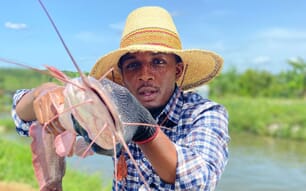The demonstration farm is being built on 13,200 m2 of land, or 3.2 Acres. The site is located adjacent to the Company’s HU plantation in Enping, China.
The 6,000 m2 demonstration farm will be housed in two pre-engineered metal frame buildings which are fully insulated. The additional infrastructure improvements such as roads, drainage, dams and power supplies recently built will be shared coordinately with and beneficial to the Company’s HU operations.
Site work has commenced with clearing, leveling and utilities being installed at the location. The company has also completed all required water quality, quantity of inflow and soil testing at the site.
The demonstration farm will provide chemical and pollution free organic fish and fish products. The system recycles water at 120 m3/ 0.5 hour, or the equivalent of 48 times per day. Rate of water usage per day will be less than 2.5 per cent and power consumption at less than five per cent of the overall annual production cost making the operation one of the most efficient fishery operations in China.
All wasted water (projecting 0.25 per cent / day’s tank water) will be used to fertilise the adjacent HU Plantation. Current production will consist of Sleeping Cod, Flat head fish, Fresh water Big head Prawns and a combination of 5/6 other common Chinese species. With stocking density of 2.5Kg per /M3 the demonstration farm will be capable of producing up to 35 Metric tons per year. The site once completed will consist of the following:
- Grow-out modules that will have eight modular tanks each measuring 7m x10m x 2.1m of which will be individually operated.
- Built-in filtration and equipment compartments housing the water treatment equipment that will filter and treat the water (including treatments of all solid wastes and soluble wastes).
- Heating units to heat up the tank water and maintain proper temperatures during the winter months.
- Infrared disease control unit, O3 water treatment unit and foam eliminators.
- Post harvesting and harvesting tanks
- A Nursery Farm consisting of the equivalent capacity of 4 Grow-out tanks (i.e. in smaller units) with the capacity to house all year round up to one million fingerlings (growing from 2 cm and upward to 10 cm) before they will be transferred to the Grow-out modules.
- Quarantine farm; with the equivalent capacity of 2 grow-out tanks (but in smaller units).
- Laboratory for treatments applied to all incoming fingerlings.
- Administrative office, feed storages, visitors show units and all associated infrastructures.
Mr Lee Solomon, Sino Agro Food CEO, stated: “We are now executing our Fishery business plan by beginning construction on our first fully operational demonstration farm in Enping, China. Once completed the farm will serve as the company’s “proof of concept” by providing Chinese businessmen, investors and government officials with the ability to tour and understand our operation.
"Our goal is to show that our system will efficiently produce quality Organic chemical and pollution free fish. Our system can be constructed inland as long as there is a viable source of water providing the ability to build additional farms in key areas where logistics are a problem.
"This will bring fresh, high quality fish products to almost anywhere in China. By building fish farms near major rural areas the company can eliminate much of the transportation and logistics costs currently associated with aquaculture fishing operations in China. This also reduces the company’s carbon footprint while producing a product of the highest quality at production costs similar to more inefficient methods currently in use.
"Though we are currently in the earliest stages of start-up operations, I believe in the years to come our fishery segment will become the single largest revenue source for the company due to the size of the aquaculture industry in China and its need for modernisation.”


